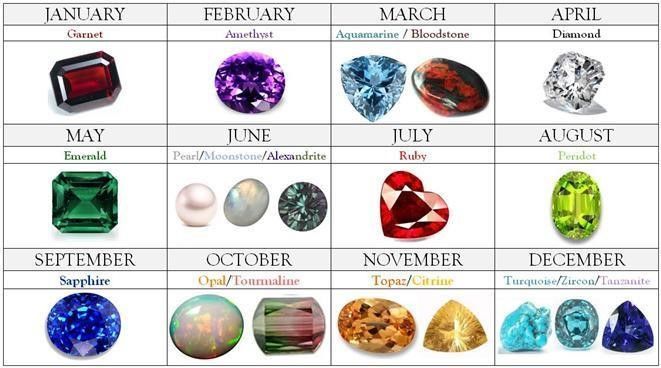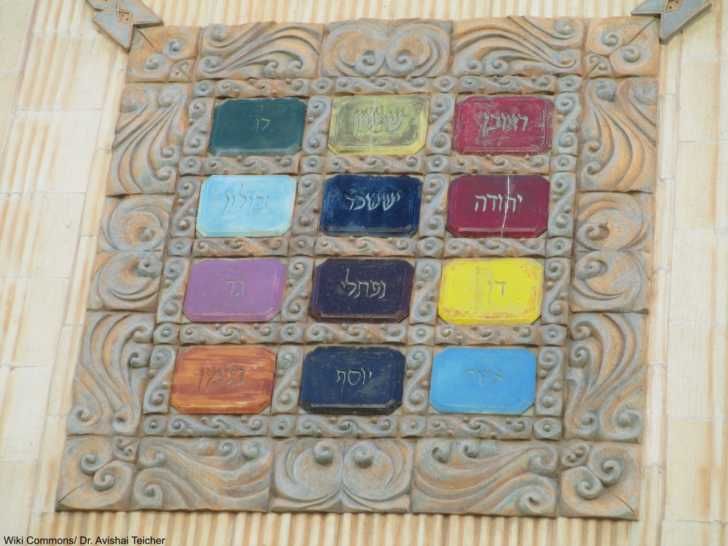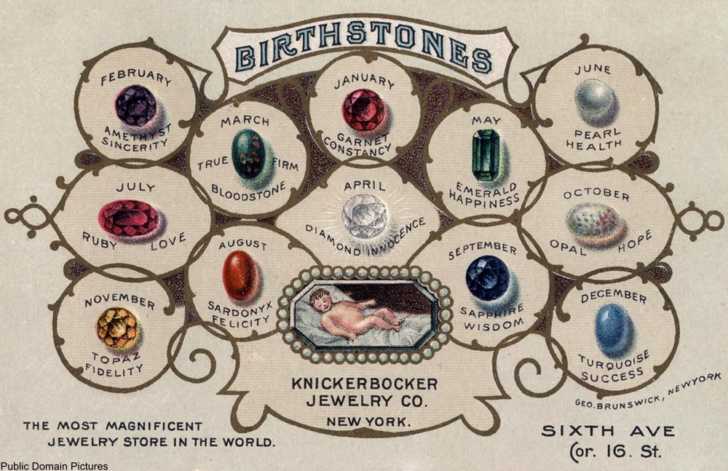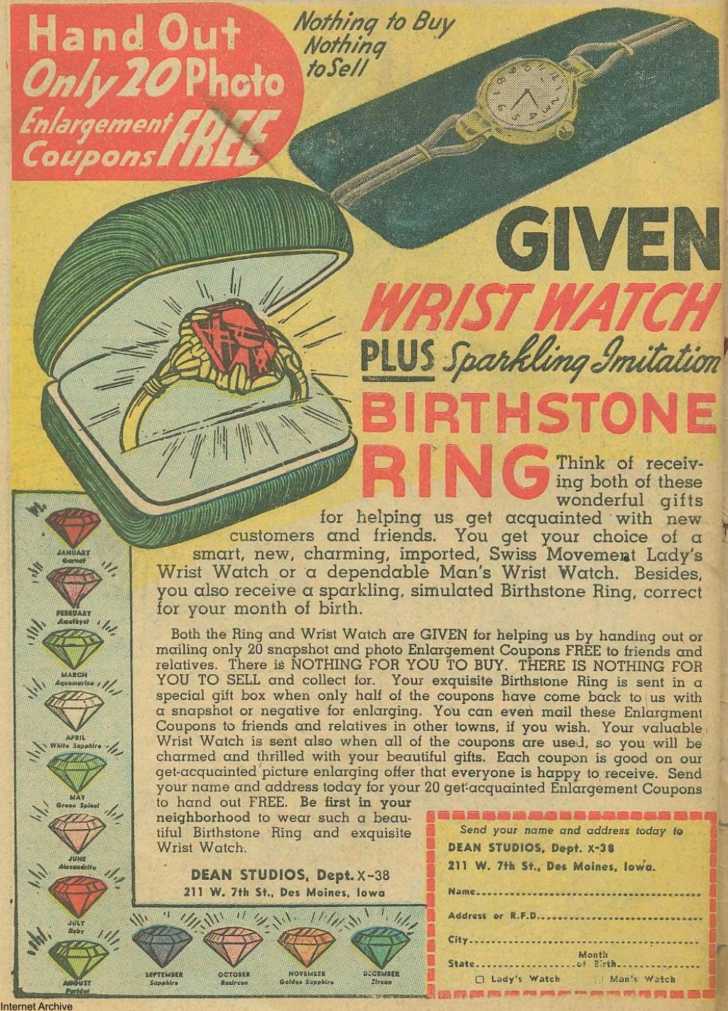The Surprising Story Behind Birthstones
Complied by Ken Rock, MSDC Newsletter Editor
Birthstones are a fun, popular and colorful introduction to the world of gemstones. They appeal to audiences around the world regardless of gender, age, nationality or religion. Although there are many stories around birthstones and the various powers these stones are said to possess, gemstones have been associated with various traits, energies, and health benefits for centuries.

You can hear people today prescribe bloodstone for courage, hematite for purification, or rose quartz for healing. But, birthstones have a much different set of connotations. They don’t have to do with healing, but instead function more like an aspect of one’s horoscope. Plus, they’re a fun way to enjoy jewelry and take the guesswork out of choosing the color of jewelry. For many women, the first piece of jewelry they ever owned contained their birthstone. But, the real story behind this tradition might surprise you.
The idea of birthstones dates back to ancient times when the Greeks, Egyptians, Romans, Persians, and Indians all assigned different gemstones to each month of the year. Legend has it that wearing a gemstone during its assigned month boosts its healing and therapeutic powers.
The birthstone system we use today originates from the biblical system created around 40 AD. Jewish historian Titus Flavius Josephus declared that the 12 stones in Aaron’s breastplate had a special connection to the months of the year and the signs of the Zodiac.

The Creation of a New Craze
You will see that there are quite a few differences in which stones are used for Aaron’s breastplate and which ones are used now and there a couple different reasons for that. The first is that in 1913 the vice president of Tiffany & Co., Frederick Kunz, wrote a book on the folklore of gems called The Curious Lore of Precious Stones. In this book Kunz outlined some ancient beliefs that went along with some commonly used gems, as well some more general findings.

Kunz wrote that to imagine the magical or supernatural in a stone was “not an unnatural reaction to the progress of materialism” for those of high imagination or romantic spirit.
The modern list of birthstones was drawn up by the American National Association of Jewelers (now called the Jewelers of America) at a meeting in Kansas City in 1912. These were the stones that jewelers in America most wanted to sell. One of the the greatest mysteries about the birthstone system is how widely it was was accepted, even if it had no provenance beyond a Missouri boardroom.
The gems approved by the association would have been those which were obtainable and profitable for the U.S., not necessarily the gems of the Middle East in ancient times. The difference between the Exodus gems and modern birthstones varies in type of stone. Modern day birthstones center more around the so-called precious gemstones, while in antiquity the stones were more varied and included more of the semi-precious gemstones. So what’s the difference anyways? Well, just like the concept of birthstones was invented used as a marketing ploy, so too, was the arbitrary distinction between precious and semi-precious gemstones made in order to sell off stock of sapphires, rubies, emeralds, and diamonds.
In any case, the idea of birthstones took off by the middle of the 20th century and imitations were popping up all over. Faux gemstone rings and earrings were plentiful in the 1940s onward, as were pieces of real gemstone jewelry. The practice became commonplace, with notions about magical powers gradually being replaced by a healthy market for this new fad in jewelry.

Until the end of the 1960s, 94% of the couples in Japan used the bride's birthstone for their engagement ring. Even today, people throughout the world choose gems according to a arbitrary decision made by business people more than a century ago.
The Jewelry Industry Council of America updated the list in 1952 to add alexandrite for June, citrine for November, and pink tourmaline for October. Other updates included adding tanzanite as a December birthstone (2002) and spinel as an additional birthstone for August (2016).
Below is a more comprehensive listing of birthstones by timeframe (source: Wikipedia)
| Month | 15th–20th century[1]: 315 | U.S. (1912)[1]: 319–320 | Britain (2013)[9] | U.S. (2019)[10] |
|---|---|---|---|---|
| January | garnet | garnet | garnet | garnet |
| February | amethyst, hyacinth, pearl | amethyst | amethyst | amethyst |
| March | bloodstone, jasper | bloodstone, aquamarine | aquamarine, bloodstone | aquamarine, bloodstone |
| April | diamond, sapphire | diamond | diamond, rock crystal | diamond |
| May | emerald, agate | emerald | emerald, chrysoprase | emerald |
| June | cat's eye, turquoise, agate | pearl, moonstone | pearl, moonstone | pearl, moonstone, alexandrite |
| July | turquoise, onyx | ruby | ruby, carnelian | ruby |
| August | sardonyx, carnelian, moonstone, topaz | sardonyx, peridot | peridot, sardonyx | peridot, spinel |
| September | chrysolite | sapphire | sapphire, lapis lazuli | sapphire |
| October | opal, aquamarine | opal, tourmaline | opal | opal, tourmaline |
| November | topaz, pearl | topaz | topaz, citrine | topaz, citrine |
| December | bloodstone, ruby | turquoise, lapis lazuli | tanzanite, turquoise | turquoise, zircon, tanzanite |
Whether or not you believe in the healing power of these stones, one cannot deny the very interesting physical characteristics and optical properties of these stones. Birthstones are a great way to add special meaning to jewelry and make great gifts to commemorate a special birthday, anniversary, graduation, or other memorable occasion. We certainly can all agree that learning about birthstones can be an educational and entertaining experience.
Sources include: http://www.thejewelleryeditor.com/jewellery/article/stories-behind-birthstones-emeralds-rubies-sapphires-chaumet-boodles-vanleles-faberge/; https://dustyoldthing.com/real-story-birthstone-industry/
